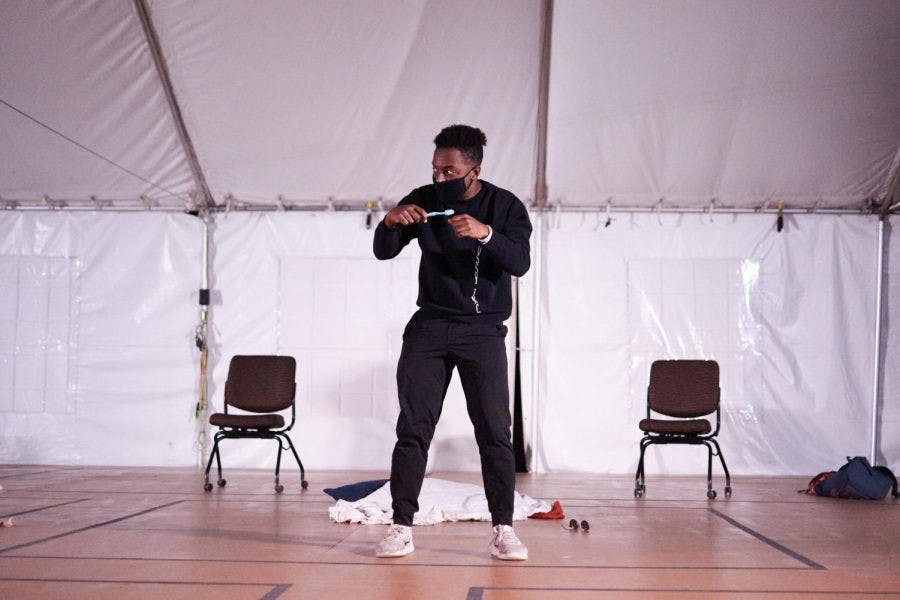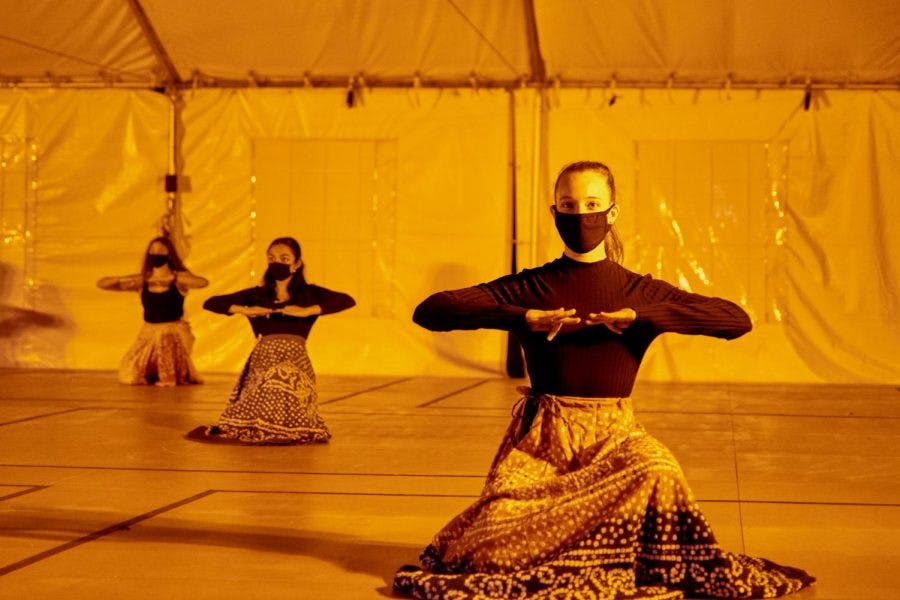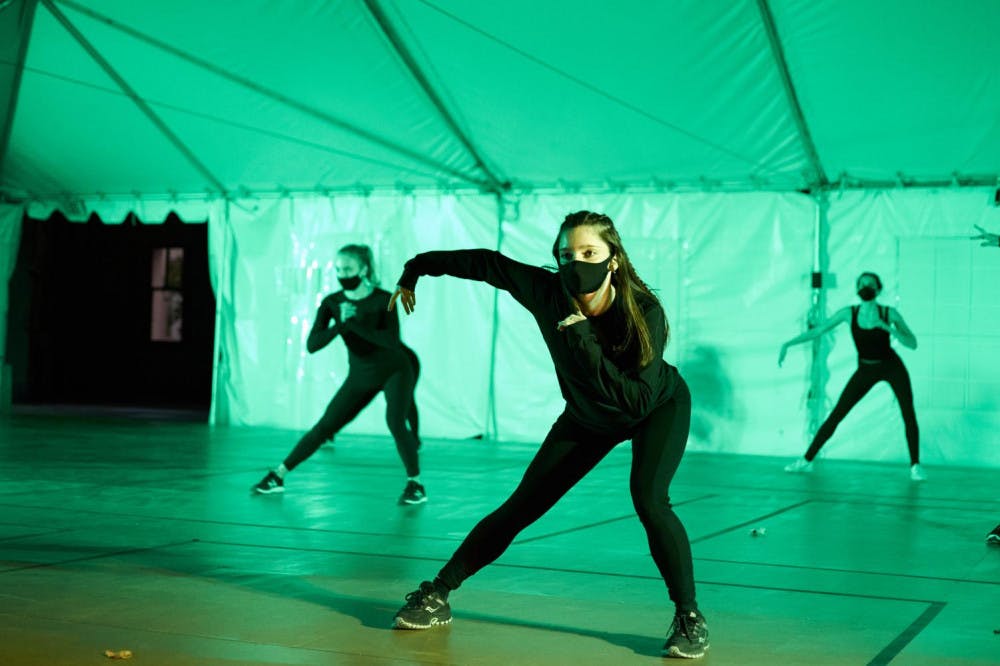Audiences joined the RIDDIM dance crew for their fall end-of-semester show “RIDDIM World Dance Troupe Zooms In” on Saturday, Nov. 14. Some spectated from a tented stage set up behind Mahaney Arts Center while others admired at a distance, watching the performance projected live on McCullough lawn. The show was performed twice — once at 6 p.m. and again at 9 p.m. — as part of the “Light Up the Night” Fall Arts Fest series.
The show opened with a video of crew members trickling into a Zoom meeting, an ode to the way interactions on campus have changed this semester. In a brief introduction, members engaged in hilarious activities without realizing their microphones or videos were on, a frequent and relatable occurrence for many taking remote classes. After the audience had a good laugh at Max Lucas ’21 turning somersaults in bed, Malia Armstrong ’22.5 putting on mascara and Jarlenys Mendez ’23 being nowhere to be seen, attention turned to the stage lit with purple lights and filled with dancers dressed in all black.
The first performance was “Studio 2020,” choreographed by Lucas, Paula Somoza ’21 and Miraal Naseer ’21. Dancers followed the beats of the rhythmic “Safety” by Gashi, bringing blistering energy to the stage even as the weather began to drop below 50 degrees. As the first dance progressed, dancers were able to demonstrate more individual moves as others provided space for them by staying low; they chose and adapted moves from across the dance spectrum, forming their own visually compelling stories.

As the dancers from the first performance ran off, six new ones appeared onstage, dancing to Ozuna, Doja Cat and Sia’s “Del Mar,” executing complicated choreography over lyrical and sexy music.
After a brief intermission, waves of dancers joined the next act, choreographed by Madeline Elkes ’22. Her piece “Stay” engaged the audience with a performance of striking synchronicity. Despite an appearance of gentleness as the crew danced to the soft whispers of singer Gracie Abrams, the moves grew forceful at times, following the rise and fall of the music. In the middle of the song, to echo its growing softness, all but two dancers left, displaying marvelous control in slowness and in speed. “Living during a pandemic is stressful, and I wanted my dance to be a stress relief for everyone,” Elkes said.
In direct contrast, the next piece, “Achey Bones,” choreographed by Anna Loewald ’21, electrified the crowd. This dance was characterized by Loewald as “a fusion footwork piece.” True to her words, dancers Lucas, Somoza and Loewald held their hands behind their backs at moments to maximize audiences’ attention on the footwork.
“I enjoyed this song particularly for this present moment as we are struggling through a global pandemic, social movements, an important election, etcetera, all subjects that cause great fear, anxiety, and sadness,” Loewald said.
After the dancers exited the stage, it remained empty for an extended period of time. Just as some began to wonder where the dancers had gone, murmuring words among themselves, the performers appeared unexpectedly on stage with colorful dresses. Until this point of the night, the dominant tone on stage had been black and white, and this sudden infusion of colors was surprising to many. This was the beginning of “Aadam Tarana,” choreographed by Amun Chaudhary ’23.5 and Miraal Naseer ’23, a piece that was inspired by South Asian dance style Kathak, which stresses storytelling, expression and fluidity. The name “Tarana” is a reference to a focus on movement and a style heavily influenced by dances of the court and the palaces in South Asia.

Next was “Psychoanalysis,” which featured a green-lit stage and chill beats. Isabelle Davis ’21, the choreographer of the piece, described it as “blending different modern techniques that I have studied and channeling this into a fresh take on modern style dance.”
Following the piece, chairs, blankets and pillows were brought on stage for a short but engaging transition performed to the Kanye West song “Famous.” Dancers hastily got dressed, put on coats and rushed to their seats to read. The transitional piece served as a mediator between “Psychoanalisis” and the next dance “My Emotions,” choreographed by Lucas, who described it as a “a chilled-out, nostalgic [one] with elements of urban and hip-hop dance movements.” Positioned in a triangle, dancers on the three vertices crouched down as others stood, relaying riveting vitality from different levels.
In a whiplash-inducing style shift, the next dance, Leeeć, was a Polish-folk-dance-inspired piece. The performance touched on themes of nature, mythology and death, according to choreographer Lucas. The next piece came at another 180-degree twist — “Electricity,” designed by Ali DePaolo ’23. DePaolo worked through the initial stages of choreographing this piece with teammates through Zoom, teaching from a room in BiHall to dancers in their respective dorm rooms. In an email to The Campus, she wrote, “I wanted to create an opportunity for people to try a new style, learn some classic jazz technique and showcase personality on stage.”
Next up, “Perfect Pose,” choreographed by Kevin Mata ’22 made an “explicit attempt to understand what it means for different bodies to perform femininity in a celebratory way.” Dancing to Cousin Stizz’s “Perfect,” performers used their bodies to convey a strong, defiant attitude.
The night concluded with “Telephone” — in bright red lights, waves of dancers sprinted across the stage, presenting one final move for the audience before finishing with a bow. Among loud cheers, the performers blew kisses to the audience through masks. The show was captivating from the first ding of someone entering a Zoom meeting to the final strike of poses.

Rain Ji '23 is a managing editor of The Campus. She previously served as an Arts & Culture editor.
She is majoring in International and Global Studies with a concentration in the Middle East and North Africa. Previously, she studied abroad in Amman at the University of Jordan. Outside of academics, she enjoys watching Criminal Minds and skiing.




